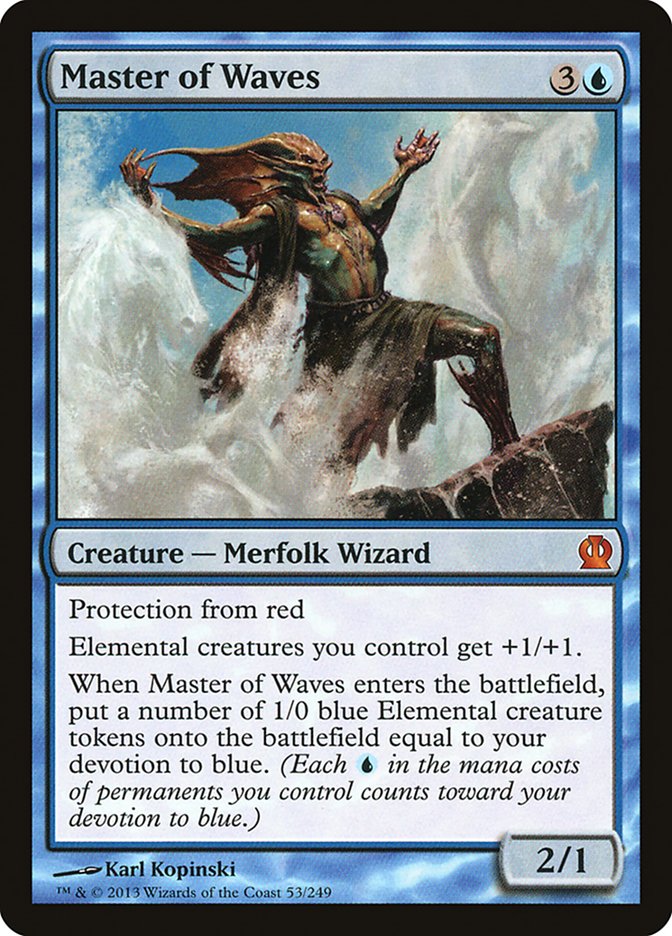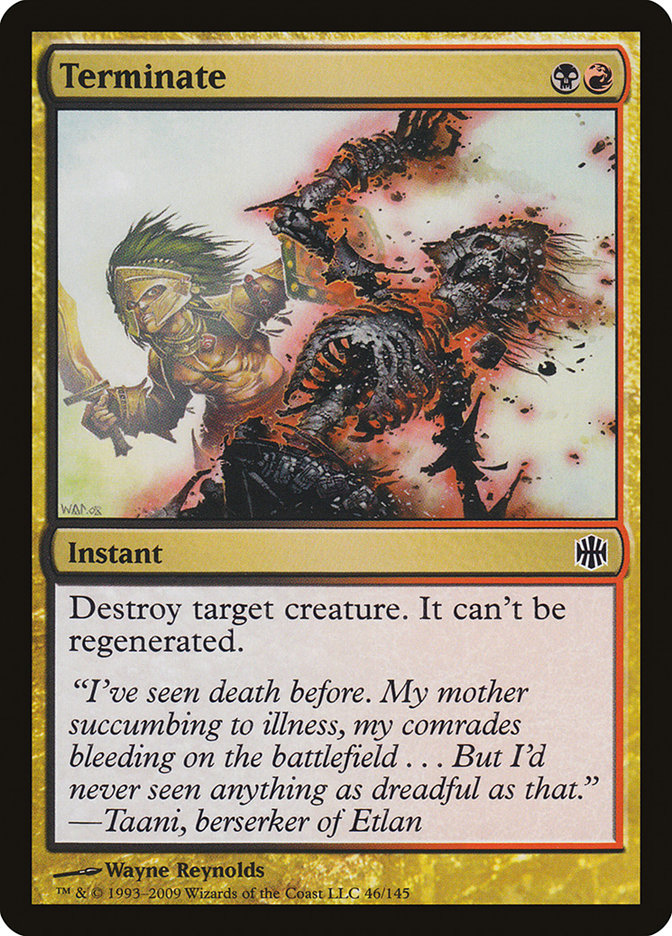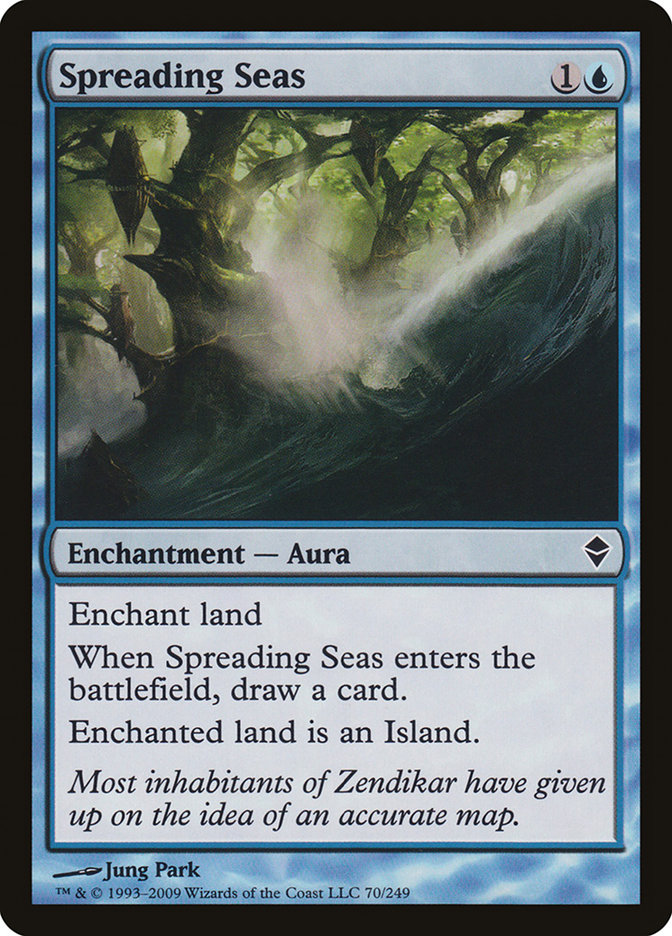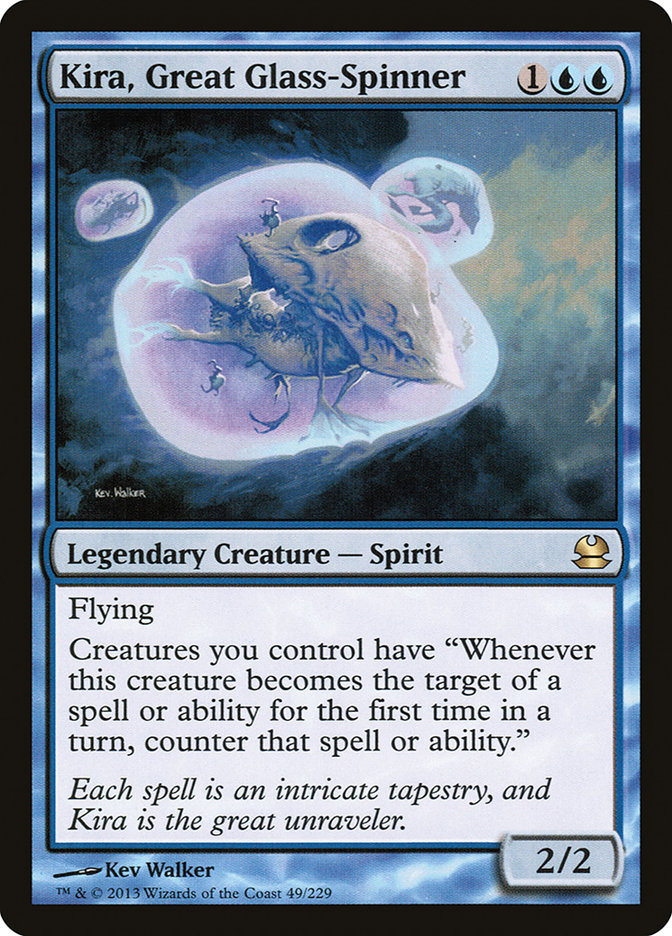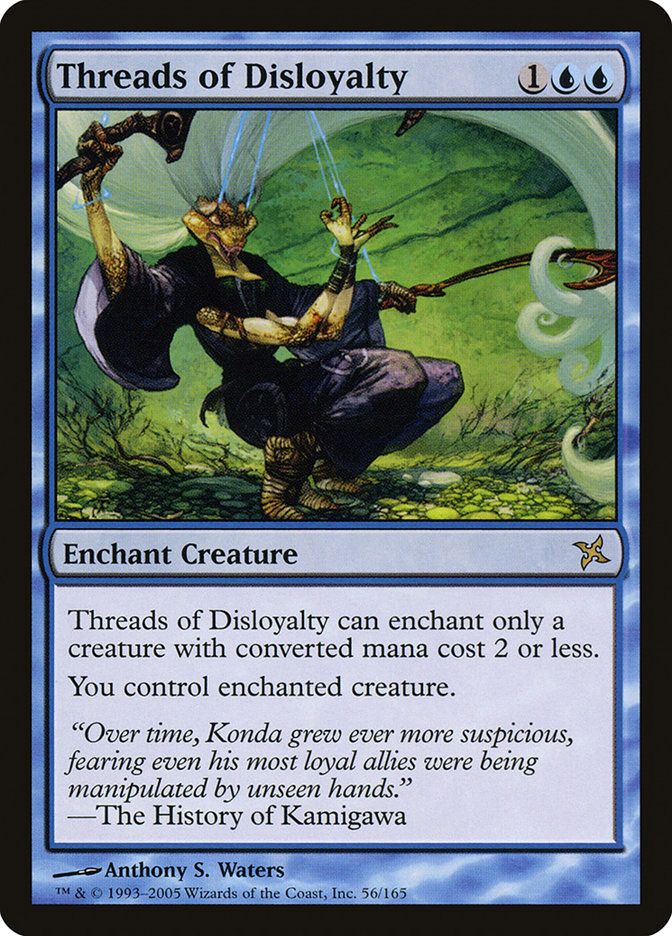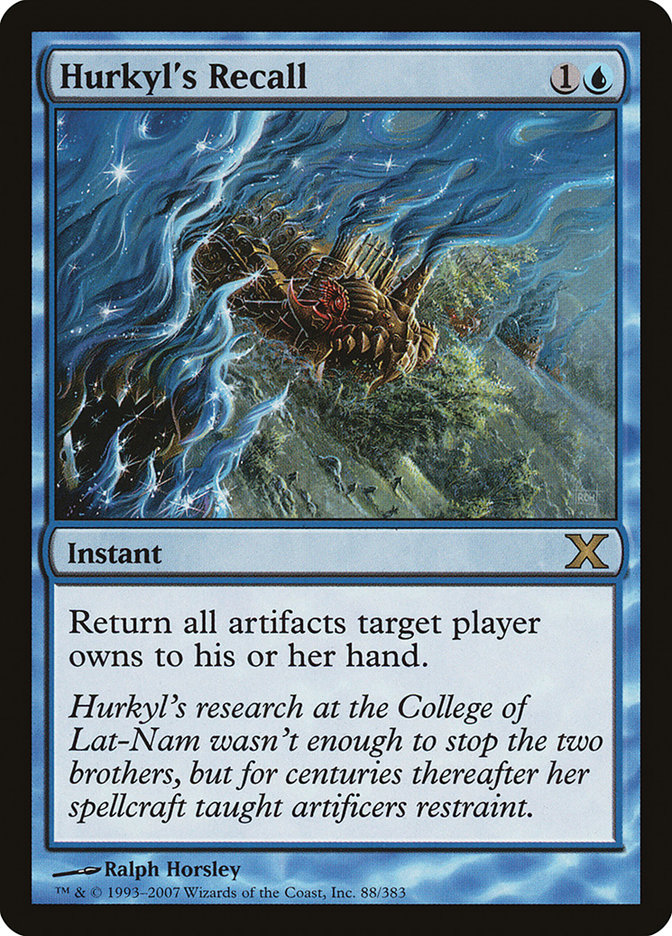It all started with an idea.
An idea that there could be a bridge between Standard and Legacy that is actually fun. Modern was that idea, and it was one that I wanted to get behind. It was going to be glorious and breathe new life into cards that had been long since been forgotten, left to gather dust in old binders in older closets. Modern was in theory a renaissance.
This non-rotating format seemed poised to reshape how we think about cards, giving us new parameters for collectability and deckbuilding. This format, this idea gave us a new outlook on . . . basically everything that has to do with the game of Magic. It had been so long since we had a "true" Extended format. The one I grew up with. The Pernicious Deeds and Tinkers. The Mind’s Desires and Hermit Druids. The fair and unfair alike. I just knew that Modern was going to be my favorite format, letting me experience cards and decks from my long-lost childhood.
Where oh where did everything go so horribly wrong?
The banned list for Modern is extraordinary. I mean, just look at it. You can’t sit here reading this and believe that Wild Nacatl should be on that list. At this point I can’t even believe that Bitterblossom is still on that list. Was Faeries really that powerful in Standard? Maybe, but what about now that we have ten other years’ worth of cards at our disposal?
The biggest problem with the Modern banned list is the bottleneck. Once you ban a card for some reason or another, you create this lasting effect, an expectation of what you want for the entirety of the format. If you ban Wild Nacatl because aggressive decks are too linearly built, what happens if aggressive decks fall off the map entirely? If you ban Bloodbraid Elf to stop Jund and it continues to dominate, then what’s next?
So now it has all come down to this.
Since its debut at Pro Tour Return to Ravnica, Deathrite Shaman has been hell for Modern. It has singlehandedly pushed Jund decks to the forefront of the format, giving them an absurd mana accelerator that acts like a Swiss Army knife once it runs out of things to cast.
Don’t misunderstand me. I don’t think that Deathrite Shaman deserves to be banned. When a Birds of Paradise proxy is too strong of a card in a format, something needs to change fundamentally about that format. The hammer has come down too hard and too often for my taste, but it is what it is. We have to work within our confines to figure out what to attack and how to attack it. I’ve traditionally been pretty good at coming to terms with the obstacles in front of me and finding a way around them (or through them on occasion). This current Modern format is no different.
But the fact remains, when was the last time you saw a true-to-life aggressive deck in Modern?
Odds are that you haven’t seen one in a while or at least not one that was very good. The reasons for this are plenty. Lightning Bolt is too strong. Combo decks are too consistent or too fast. The tools just aren’t there for the aggressive decks to keep up, and they’re starting to seem more and more like a thing of the past.
Don’t fool yourself. Jund is not an aggressive deck. It might look like an aggressive deck because it is basically the only deck in the format that is trying to play fair. Everything else is just a combo or control deck with a little bow on top. A one-trick pony with an endgame that seems relatively unstoppable because Wild Nacatl was just a bit too much for Karn Liberated.
So where does it end? Will banning Deathrite Shaman fix things? What about Birthing Pod, or Cranial Plating, or Urza’s Tower, or Splinter Twin, or any card that uniquely identifies one of the major archetypes in Modern? For Modern’s sake, I’m praying for something to come along and actually breathe life into this massacre of what was once a great idea.
I want the Wild West. I want access to anything and everything for just a few months. I want to see what decks are actually too good. I want to look atthe monsters eye to eye and cackle as I strike them down. I want to Mental Misstep a Wild Nacatl. I want to Stoneforge Mystic into Sword of the Meek. I want to suspend a damned Ancestral Vision. Is that really too much to ask for?
The Evolution of (Mer)Man
For the last few weeks, I’ve been playing a lot of Modern on Magic Online and primarily been working on one particular strategy.
Ever since this guy was spoiled in Theros, I knew there had to be some shell for him to work in Standard. Little did I know he would make a splash in Modern too! But something just clicked. He fit right into a shell that didn’t have a great finisher and dodges almost all of the most popular removal in the format. When Jund is Goliath, Master of Waves seems poised to be David.
These are the main removal spells that Jund plays. Do you see the hole in their plan? Jund doesn’t really have a great answer to Master of Waves. While most Jund lists still play some small number of Maelstrom Pulses, the fact is you can play a number of cards that can easily protect it. Spell Pierce and Kira, Great Glass-Spinner are poised to punish Jund and their lack of ways to interact with Master of Waves.
With Master of Waves being the goal, the rest of the deck was simple enough to construct. You wanted Silvergill Adept because, come on, who doesn’t love value? You also wanted some number of lord effects to make your squad formidable and actually have a chance at racing a combo deck. On top of that, you needed a few pieces of spot removal and a little more disruption.
The original build for Merfolk was all Islands all the time, with Mutavault thrown in because it was just too strong with so many ways to pump it. There was a point where Tectonic Edge was the other utility land, but it was mediocre at best and ultimately got the axe. It was great on occasion, but you had so many double-blue requirements that it just wasn’t feasible to play it alongside Mutavault, which was superior in almost every way.
My biggest trouble with Merfolk was that Spell Pierce and Spell Snare just weren’t strong enough to contain all of the combo decks that went big. Scapeshift was running all over the place, and Tron was a real problem. In a format so volatile with combo decks that all need require interacting on different levels, the solution was just on the tip of my tongue, but I couldn’t figure it out until the Tannon Grace asked the question:
"Why aren’t we just playing Thoughtseize?"
Huh. Just like that, eh? You think we can just jam Thoughtseize into the deck without it hurting is in any way? What, should I just play River of Tears and get it over with?
Well, to be honest, I liked the idea. Actually, I loved the idea. I just wish I had thought of it before going through multiple iterations of the mono-blue version. Thoughtseize was the card I wanted. No, Thoughtseize was the card the deck needed to have a chance at competing in such a hostile metagame. It is the great equalizer and keeps basically everything in check, giving you enough time to finish the job against virtually any opponent. While it is still a race against the top of their deck, Thoughtseize gives you a lot of breathing room.
Glub Glub
After working on this deck for the last week or so, I’ve finally come to this list:
Creatures (22)
- 2 Kira, Great Glass-Spinner
- 4 Lord of Atlantis
- 4 Silvergill Adept
- 1 Vendilion Clique
- 3 Cursecatcher
- 4 Master of the Pearl Trident
- 4 Master of Waves
Lands (22)
Spells (16)
Sideboard

On paper I will admit that the deck looks underwhelming. There doesn’t seem to be a whole lot going on that seems tricky or new, and for the most part that is the case. Your game plan involves playing an early Aether Vial and then following it up with a few pieces of disruption while you play a couple of creatures for free. Eventually, you will build a force large enough to kill your opponent, either with lords or with a single Master of Waves, as long as everything goes according to plan. There are a few cards in the deck that help facilitate this plan, and they do it quite well.
Spread ‘Em Out
First, Spreading Seas is fantastic on multiple levels. It turns on the Islandwalk of your lords when your opponent is silly enough to forego playing Islands of their own and draws a card to boot. This is useful when trying to trudge through a gummed-up board of Tarmogoyf and the like but is even helpful when your opponent plays a nuisance like Kitchen Finks or Wurmcoil Engine. While playing with this deck, you will notice just how important the Islandwalk is in a variety of matchups.
Against a lot of the greedier mana bases in Modern Spreading Seas also acts as a virtual Stone Rain that draws you a card. Many archetypes aren’t able to effectively utilize a single off-color mana. Additionally, you will usually be able to turn off their access to one of their most important colors of mana. If you are able to start playing two or more cards per turn while keeping your opponent down to one or zero, then you’re going to pull ahead in a hurry. And when this deck pushes down on the gas pedal, things can get absurd very quickly.
You will also have the added ability of shutting down utility lands from the opponent. There are so many lands in Modern that do something besides tapping for mana, so having the ability to permanently turn one of them into an Island is incredibly powerful. Did you know that casting a Spreading Seas on your opponent’s Urza land will turn off the entire trio? Decks like Jund are also mana heavy, relying on Raging Ravine and Treetop Village to give them something to do if they run out of cards. Spreading Seas disrupts access to specific colors while also keeping their late game in check!
It may seem like a page straight out of 2009, but Spreading Seas is almost as good against Modern Jund as it was against Standard Jund. One thing I’ve learned from playing a good bit of Modern is that lessons you’ve already learned are still applicable. Playing with this Merfolk list has led me to want to explore it further in other archetypes.
Eating Glass
Kira, Great Glass-Spinner was a card that I hadn’t played with in basically forever. The obvious problem is that Kira is not a Merfolk, so she doesn’t gain any of the bonuses from Lord of Atlantis or Master of the Pearl Trident. But what she lacks in aggression she more than makes up for in defense. Against decks like U/W/R Control and Jund she is your main source of protection, acting as a proactive threat that also creates an intangible barrier between the removal of your opponent and the rest of your creatures.
While Abrupt Decay and to a lesser extent Combust are ways to get around her ability, Kira is able to create virtual card advantage by forcing your opponent into bad situations or negating their removal entirely. When combined with Master of Waves, the hoops your opponent has to jump through in order to survive are comical.
Kira also plays absurdly well with Spellskite, giving you near invulnerability against cards like Splinter Twin, and easily handles random fringe strategies like Hexproof and even Mono-Red Aggro. During the last tournament I played, I assembled "the combo" of Kira, Spellskite, and Master of Waves. It was basically impossible for my opponent to kill my Master of Waves, and he conceded with the triggered ability on the stack.
The main issue with Kira is that you can’t play too many copies for different reasons. She’s legendary and fairly tough to kill, so redundant copies are miserable for you to draw. I’ve toyed around with two and three copies in various iterations, and I’ve never really wanted more than two. When you draw one, it is fantastic, but drawing two usually means you’re not putting enough pressure on the opponent. Kira is also lackluster against decks that don’t like to interact. She doesn’t put up much of a clock, and the utility is invalidated by the fact that your opponent can just choose to not interact with your creatures.
All Aboard
The sideboard is built to handle cards or decks that your maindeck is inherently weak against. Cards like Negate and Swan Song shine against a variety of archetypes, giving you ways to interact favorably against strategies that would otherwise overwhelm you. Alongside Thoughtseize your counterspells can be the final nail in the coffin.
Swan Song is a strange card, but it is hard to argue with a one-mana counterspell against combo decks. When you are fairly land light and need to continue dropping threats, one versus two mana can mean all the difference. However, Swan Song doesn’t actually counter all of the cards you need it to. There are things like Oblivion Stone and Karn Liberated out of Tron that need real answers, and Negate is obviously much better in these situations. But it is pretty hilarious how little the 2/2 flier matters when your entire team regularly has Islandwalk thanks to all of your lords.
The Spellskites have been absurd against a wide range of opponents. Splinter Twin, Burn, Hexproof, and a variety of other decks all like to target something, and I like for them to target Spellskite instead. The threat of an Aether Vial on two against Splinter Twin is very real.
Threads of Disloyalty is one of the best answers you can have against a Tarmogoyf deck. Being able to steal their marquee creature while adding two points to your devotion to Master of Waves is outstanding. While Threads of Disloyalty is often deadly because it steals their best creature, it is not uncommon to just steal a Deathrite Shaman while you use Spreading Seas to disrupt the rest of their mana. Threads is also one of the best cards for any sort of mirror match since whoever has the most lords usually wins. But be careful! Your Lords of Atlantis pump their creatures too!
Affinity is a relatively tough matchup for Merfolk, so I don’t want to come into it empty handed. Hurkyl’s Recall seems fairly strong against them, but honestly it isn’t a card that I want to draw when I need to play catch-up. I want Recall when I’m trying to race, as it generally buys me a turn to swing through for lethal. One of the toughest draws for you to beat out of Affinity involves Etched Champion with an attached Cranial Plating. If you’re able to catch them off guard mid-combat after tapping most of their mana, then you should be in great shape. Otherwise, Recall is going to just buy you a single turn. Make it count!
Lastly, we have Grafdigger’s Cage, which I absolutely hate. Unfortunately, Birthing Pod decks can also be problematic. They have a lot of different angles of attack and can turn the corner in just a single draw step. Birthing Pod or Chord of Calling off the top can be devastating, which is a major reason we want access to Grafdigger’s Cage over something like Relic of Progenitus. While Relic of Progenitus has utility in other matchups like Jund, Grafdigger’s Cage shuts down their Persist combo while also keeping their tutors in check.
Fish in Every Format
After watching the Vintage Champs this past weekend, I am not surprised to see Merfolk holding strong. Cheap creatures backed by cheap disruption has always been a key to success in combo-heavy formats. With True-Name Nemesis making a name for itself in the Eternal formats, I fully expect to see a resurgence of Fish in Legacy. The interaction between Phantasmal Image and True-Name Nemesis is just hilarious, but having a creature that survives virtually every removal spell and can pressure Jace, the Mind Sculptor can’t be ignored.
With Show and Tell being one of the best decks around, Merfolk seems like a good place to be. Daze, Spell Pierce, Force of Will, and Flusterstorm help make up a solid core of disruption to go along with Wasteland. I fully expect Merfolk to be on the rise in the coming weeks across Modern and Legacy, and I would bet even money that some tempo-oriented deck with True-Name Nemesis cracks through into the Top 8 of Grand Prix Washington DC next weekend. I don’t know what I’m going to be playing in the Grand Prix just yet, but I will be working on it over the coming weeks.
But as for this weekend? I’m going to be at home grilling steaks, hanging out with my wife and friends, and doing exactly what I want to be doing: nothing. And after traveling for the last three weekends in a row, it will be a glorious change of pace.
Todd Anderson
strong sad on Magic Online
@strong_sad on Twitter


